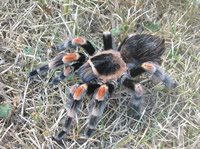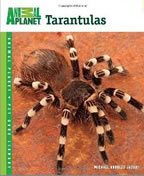Choosing A Tarantula
© 2000-2013, Michael Jacobi and TARANTULAS.com
After reading this page, please also visit our Care Videos page and view the video clip regarding "Choosing Species"
Introduction
 One of the questions I am asked most frequently is "which tarantula is best for the beginner?" Certainly each keeper's needs are different, but typically what a person seeks in his or her first tarantula is one that is easy to care for and calm in temperament. Tarantulas in general are low maintenance pets, but those that are easiest to care for are those that can be maintained at room temperature in a warm home without any supplemental heat, and those that tolerate a dry cage with a small water dish supplying the only moisture. These are the grassland or desert species. Tropical varieties may require a little more warmth and almost always require somewhat elevated humidity. As for temperament, beginning keepers also understandably desire a species that is not likely to bite. Some keepers wish to hold their tarantulas. This is a controversial subject that I won't address at length here, but I do not advocate handling. In short, tarantulas are extremely fragile creatures best left alone. I consider them fascinating hands-off terrarium subjects, no different than tropical fish or frogs. The spider gains nothing from being touched and it is put at great risk of injury when a keeper chooses to hold it. Personally, I have a dog and a parrot to interact with. Others have ferrets or bearded dragons or boas. I enjoy observe and care for my tarantulas - I don't bother them. I'll leave it at that. But, all of the species mentioned here are those that have dispositions that lend themselves to handling if the keeper chooses.
One of the questions I am asked most frequently is "which tarantula is best for the beginner?" Certainly each keeper's needs are different, but typically what a person seeks in his or her first tarantula is one that is easy to care for and calm in temperament. Tarantulas in general are low maintenance pets, but those that are easiest to care for are those that can be maintained at room temperature in a warm home without any supplemental heat, and those that tolerate a dry cage with a small water dish supplying the only moisture. These are the grassland or desert species. Tropical varieties may require a little more warmth and almost always require somewhat elevated humidity. As for temperament, beginning keepers also understandably desire a species that is not likely to bite. Some keepers wish to hold their tarantulas. This is a controversial subject that I won't address at length here, but I do not advocate handling. In short, tarantulas are extremely fragile creatures best left alone. I consider them fascinating hands-off terrarium subjects, no different than tropical fish or frogs. The spider gains nothing from being touched and it is put at great risk of injury when a keeper chooses to hold it. Personally, I have a dog and a parrot to interact with. Others have ferrets or bearded dragons or boas. I enjoy observe and care for my tarantulas - I don't bother them. I'll leave it at that. But, all of the species mentioned here are those that have dispositions that lend themselves to handling if the keeper chooses.
First Step
Read our Basic Tarantula Care Page.
Second Step
Obtain and read "Tarantulas and other Arachnids" by Dr. Sam Marshall, published by Barron's [2001] and available in specialty pet and reptile shops, as well as from numerous online retailers [see link in this page's sidebar]. Please remember that while there is an abundance of information on tarantula care on the Internet, much of it is inaccurate. Care sheets written by well-known breeders are best, as is the information provided on the British Tarantula Society and American Tarantula Society websites.
Third step
Buy captive-bred. There are many reasons why captive-bred animals are superior, not the least of which are health and longevity and not contributing to the capture of wild animals and destruction of habitat. The young captive-bred tarantulas we sell allow you to raise them and watch them grow for many years.
SPECIES DESCRIPTIONS
What follows is just a brief overview of species and is by no means intended to be a primer on keeping tarantulas. The best beginner species tend to be from the genera Brachypelma and Grammostola. These are scrub desert or grassland species that are easy to keep and are typically calm. They do flick urticating hairs, especially the Brachys, but these are the spiders people choose when they are looking for something they can touch or hold. A few others such as Chromatopelma and Avicularia are excellent terrarium pets, but have a more skittish temperament.
click on linked popular name to view photo
Brachypelma smithi | Mexican Redknee
Brachypelma emilia | Mexican Painted Redleg
Brachypelma boehmei | Mexican Fireleg
The "red-legged" tarantulas from the Pacific coast of Mexico, best represented in the hobby by these three species, are colorful, hardy and usually quite docile. The Mexican Redknee, B. smithi, has been the 'classic' pet tarantula for over 30 years and there is good reason for that (see photo at top of page). It is one of the most popular first tarantulas. Now protected in the wild, the genus Brachypelma is well-established in the hobby with captive-bred animals readily available. A female can live in excess of 30 years making it a sort of heirloom pet. The most significant problem with these tarantulas is their penchant for 'flicking hairs' or rubbing the urticating hairs off their abdomens in defense. People vary in their sensitivity to this irritant, but it is something to keep in mind. Even the calmest specimens will 'flick' when disturbed, resulting in a bald spot on the abdomen as these hairs are used over time. Of course, these hairs are replaced with each molt and the bald spot disappears temporarily.
Brachypelma albopilosum | Curly-hair
This Central American cousin of the red-legs is much more plainly colored, but it has long, woolly 'hairs' and is large and 'gentle'. It is fairly inexpensive and easy to raise, making it a terrific first tarantula.
Chromatopelma cyaneopubescens | Greenbottle
Blue
This incredibly colorful tarantula inhabits a very harsh dry climate and, as a result, is extremely hardy in captivity and a great choice for beginners. It is a bit skittish and not recommended for handling, but it is an excellent display species that will stay out in the open, is fairly active and will create fascinating silken retreats. They are voracious feeders and young spiders will take food as big as themselves. This is a hugely popular species that we highly recommend.
Grammostola pulchripes (formerly G. aureostriata) | Chaco Gold-striped or Goldknee
This is one of my favorite "pet" tarantulas. I like to refer to it as the "Golden Retriever" of the tarantula world. It is big, beautiful and extraordinarily 'docile', not to mention very easy to keep. Unfortunately, wild-caught adults used to be so prevalent in the pet trade that very few breeders focused their efforts on producing the species. Then Paraguay closed to export of wildlife and these adults became scarce. Now only captive-bred spiders are available, which is a good thing both for hobbyists and the wild populations. But, they are slow growers and, as already mentioned, they aren't widely bred.
Grammostola pulchra | Brazilian
Black
This is one of the most in-demand tarantulas in the hobby and certainly one of the most difficult to find. It is a deep black, gentle giant and an exceptional terrarium pet, but has proven difficult to breed and imported adults haven't been available for years. It commands a high price when available, which is not very often.
Eupalaestrus campestratus | Pink Zebra Beauty
Although they don't get quite as large or colorful as the "Chaco Gold-striped", everything said about the chaco could be said about the PZB. These are docile spiders. It is from the same country and also is no longer available as wild-caught adults. But it is even less commonly bred, and therefore harder to find, and seems to grow even slower.
Avicularia versicolor | Antilles Treespider
This is an arboreal [tree-dwelling] tropical tarantula. It's a bit more difficult for beginner's to rear due to its more specific temperature and humidity requirements. However, those who are willing to put in the effort to maintain suitable conditions, are rewarded with a fascinating spider that does well in a naturalistic terrarium [vivarium]. All of the "Avics" or pink-toed tarantulas build silk tubular retreats and have interesting habits.
Aphonopelma seemanni | Stripe-knee
or Zebra
The wide-ranging genus Aphonopelma includes the spiders of the American Southwest, which are plainly colored but hardy and easy to keep. The most popular member of the genus is a much more attractive Central American species known as the Stripe-knee. It is also often called the "Costa Rican Zebra", but it actually ranges throughout much of Central America with paler specimens coming from the north of the range and still being imported as wild-caughts, while the darker, more attractively colored 'true Costa Rican' form is only available as captive-bred.
Grammostola rosea or G. porteri | Chilean
Rose or Rosehair
I put this one last for a reason. I have to include it here because it is the most common tarantula in the pet trade, with a seemingly endless supply of wild-caught adults making their way into pet shops. It is the one most beginners end up with. However, this is a problematic species that frustrates many new keepers and may discourage further exploration of the tarantula hobby. I don't recommend it. To read more about why, please read my Chilean Rose Answer Page.



